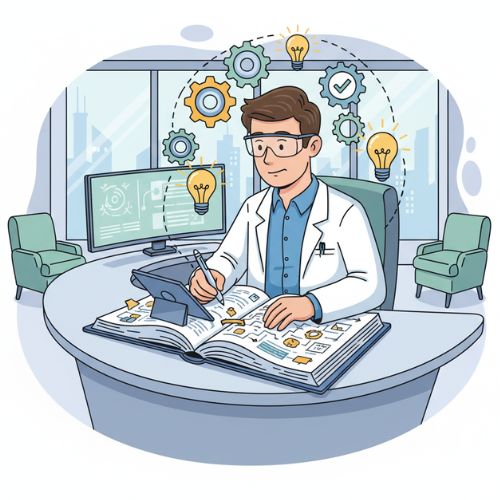Four Tips to More Effectively Managing a QMS
A quality management system (QMS) is a systematic approach to managing an organization's processes to ensure consistent quality in products and services. With an effective QMS in place, organizations are better positioned to achieve their quality objectives, improve customer satisfaction, and achieve greater efficiency.
However, managing a QMS across an entire organization can be a complex and challenging task. Employees may disagree on what the QMS should look like, while some are resistant to technological innovation. That’s why we’re sharing four tips that can help organizations to manage their QMS more effectively and achieve their quality objectives:
- Prioritizing continuous improvement
- Fostering a culture of collaboration and accountability
- Implementing effective communication strategies
- Using technology such as a chatbot to automatically answer QMS questions
Prioritizing Continuous Improvement
Prioritizing continuous improvement is crucial for an effective QMS. Continuous improvement means regularly reviewing and updating processes to identify areas for improvement and increase efficiency. It requires a mindset that is focused on identifying and fixing problems as they arise, rather than waiting for problems to escalate before taking action. This proactive approach helps organizations stay ahead of the curve and achieve their quality objectives.
One of the strongest benefits of continuous improvement is that it helps organizations identify and resolve problems before they become major issues. For example, by regularly reviewing customer feedback, a company can identify a pattern of complaints about a particular product or service. By addressing these issues early on, the company can prevent them from becoming bigger problems, avoiding possible damage to its reputation.
Another benefit of continuous improvement is that it helps organizations stay competitive in their market. By continuously updating processes and improving quality, organizations can remain ahead of their competition and meet the changing needs of their customers. For example, by incorporating the latest technology and innovations into their processes, organizations can improve the speed and efficiency of their operations, giving themselves a competitive advantage.
Finally, continuous improvement helps organizations foster a culture of excellence. By promoting a focus on continuous improvement, organizations encourage their employees to be proactive in identifying and solving problems, and to be invested in the success of the company. This encourages increased engagement, motivation, and job satisfaction, ultimately helping organizations attract and retain top talent.
Fostering a Culture of Collaboration and Accountability
Fostering a culture of collaboration and accountability is essential for the success of a QMS. Collaboration involves encouraging all team members to participate in the QMS and work together to achieve common goals. This helps create a sense of shared ownership and responsibility for the success of the QMS, building greater engagement and commitment from all stakeholders.
Accountability, on the other hand, refers to holding all team members responsible for following processes and meeting quality objectives. This can be achieved through regular performance evaluations, clear communication of expectations, and a system of rewards and consequences for meeting or failing to meet these expectations.
There are numerous benefits to fostering a culture of collaboration and accountability. First, it helps to ensure that all team members are aware of the QMS processes and their role in achieving quality objectives. This leads to greater consistency in the quality of products and services, and a reduction in errors and defects.
Second, a culture of collaboration and accountability promotes continuous improvement. By encouraging all team members to contribute to the QMS, organizations can tap into the collective knowledge and expertise of their employees, leading to more effective solutions to problems and the identification of new opportunities for improvement.
Finally, a culture of collaboration and accountability helps create a sense of shared responsibility for the success of the QMS. This builds trust and transparency, which can improve communication and reduce conflicts among employees and leadership.
{{cta}}
Implementing Effective Communication Strategies
Effective communication is crucial for the success of a QMS. Clear, consistent and timely communication helps ensure that all stakeholders are aware of QMS processes and can contribute to the success of the system.
One key aspect of effective communication is clarity. All stakeholders should understand the processes, objectives, and expectations associated with the QMS. This can be achieved through clear and concise documentation, regular training and updates, and regular feedback and review.
Consistency is also important in effective communication. All stakeholders should be aware of the same information, and this information should be communicated in a consistent manner. This helps to reduce confusion and ensure that all stakeholders are working towards the same objectives.
Timely and effective communication is also essential. Information about changes to processes or objectives should be communicated as soon as possible to ensure that all stakeholders are aware of the latest developments and can adjust their actions accordingly.
Using Technology Such as a Chatbot to Automatically Answer QMS Questions
Using technology, such as chatbots, is another way to greatly improve the efficiency of a QMS. Chatbots are computer programs designed to simulate conversation with human users and provide automated answers to questions. They can be integrated into a QMS to provide quick and accurate answers to questions about processes, procedures, and objectives.
One of the main benefits of using a chatbot in a QMS is increased efficiency. Chatbots can provide instant answers to questions, reducing the time and effort required for manual research and communication. This frees up valuable time for other important tasks, such as continuous improvement and process optimization.
Another benefit of using a chatbot in a QMS is improved accuracy. By providing consistent and accurate answers to questions, chatbots can reduce the risk of human errors and misunderstandings. This helps ensure that all stakeholders are working with the same information and following the same processes.
In addition, chatbots can help improve communication and collaboration. By providing instant answers to questions, chatbots reduce delays and promote transparency. They can also provide a centralized source of information, which can help to reduce confusion and improve consistency.
Finally, chatbots can be easily scaled and customized to meet the specific needs of an organization. This makes them a flexible and cost-effective solution for organizations of all sizes, and can help organizations achieve their quality objectives more efficiently.
In conclusion, using technology such as a chatbot can greatly improve the efficiency of a QMS. By providing instant, accurate and consistent answers to questions, chatbots can improve efficiency, accuracy, communication, and collaboration—providing a flexible and cost-effective solution for organizations of all sizes.
Closing Thoughts
By following these tips, organizations can not only ensure that their QMS is well-managed, efficient, and effective but also that they are able to consistently deliver high-quality products and services to their customers. This is critical for organizations looking to achieve their quality objectives, improve customer satisfaction, and achieve greater efficiency.
Answers your employees need, right when they need them
Meet Botable — the AI chatbot that handles everything from simple FAQs to complex, multi-step questions, so your team can focus on what matters. Built for HR, QA, and beyond.
Continue reading
Ready to see what Botable can do for you?
Book your demo now to see how Botable can transform your workplace.
Identify your unique challenges
Flexible pricing options
Easy integrations
Step-by-step implementation plan
Customize Botable for your workflow
Book a demo
.webp)



